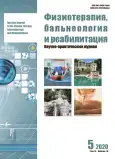Pharmacological potential strengthening of drug therapy in treating patients with chronic pancreatitis by using therapeutic physical factors
- Authors: Mallaeva R.M.1, Makhinko A.N.2, Uzdenov M.B.3
-
Affiliations:
- State Budget Educational Institution Dagestan State Medical Academy
- City Clinical Hospital № 1
- Medical Institute of North Caucasian State Academy
- Issue: Vol 19, No 5 (2020)
- Pages: 293-298
- Section: Original studies
- Published: 20.06.2021
- URL: https://rjpbr.com/1681-3456/article/view/71696
- DOI: https://doi.org/10.17816/681-3456-2020-19-5-3
- ID: 71696
Cite item
Abstract
Background. The steady increase in the incidence of chronic pancreatitis, its aggressive course in recent years, as well as the insufficient therapeutic effect of standard techniques determine the relevance of the search for new approaches to the treatment and medical rehabilitation of this category of patients.
Aims. To improve rehabilitation treatment of patients with chronic pancreatitis (CP) at inpatient stage by strengthening pharmacological potential of drug therapy due to inclusion of therapeutic physical factors (TPF) in therapeutic programs.
Materials and methods. 159 patients with acute CP were observed. By simple randomization, 4 groups were formed: the control group (MG; n=39) received standard drug therapy; 1st comparison group (GC1; n=38) additionally received TPF; (GC2, n=40) in addition to treatment in GC1 had drinking mineral water "Slavyanovskaya"; in main group (n=42) in addition to the treatment in GC2 got preformed peloidotherapy on the cervical-collar zone. All the patients underwent the evaluation of clinical score and quality of life before and after medical rehabilitation.
Results. In MG, clinical symptomatology leveling was by 78.2% (р <0.01), in GC1 — by 71.5% (р <0.01), GC2 — by 62.3% (р <0.01), CG — by 57.2% (р <0.01) on average immediately after the treatment, which was in a clear correlation with indicators of quality of life. In the long term (in 6 and 12 months), the advantage of combination therapy was noted with the same validity, the preservation of the achieved positive result was mostly noted in the MG: after 6 months the improvement in physical health compared to the initial values was noted by 34.4% (р <0.01), after 12 months — by 24.0% (р <0.05); mental — by 32.3% (р <0.01) and 22.5% (р <0.05), respectively. In both comparison groups, positive dynamics was 10–12% lower, and in the control group, after 6 months, there was only a tendency to improve quality of life indicators.
Conclusion. The inclusion of TPF in the programs of the inpatient stage of medical rehabilitation of patients with chronic pancreatitis by strengthening the pharmacological potential of drug therapy contributes to the leveling of clinical manifestations (abdominal pain, dyspepsia and diarrhea), the result of which is an improvement in the quality of life of this category of patients.
Full Text
About the authors
Raziyat M. Mallaeva
State Budget Educational Institution Dagestan State Medical Academy
Author for correspondence.
Email: mallaeva1964@mail.ru
ORCID iD: 0000-0002-7296-9844
Cand. Sci. (Med.), Assistant Professor
Russian Federation, MakhachkalaAnna N. Makhinko
City Clinical Hospital № 1
Email: mallaeva1964@mail.ru
ORCID iD: 0000-0001-5168-5001
Russian Federation, Krasnodar
Marat B. Uzdenov
Medical Institute of North Caucasian State Academy
Email: mallaeva1964@mail.ru
ORCID iD: 0000-0002-0077-9013
SPIN-code: 7692-5669
Cand. Sci. (Med.)
Russian Federation, CherkesskReferences
- Ivashkin VT, Maev IV, Ohlobystin AV, et al. Recommendations of the Russian Gastroenterological Association for the diagnosis and treatment of chronic pancreatitis. Russian Journal of Gastroenterology, Hepatology, and Coloproctology. 2014;(4):70–97. (In Russ).
- Diagnosis and treatment of acute pancreatitis. Russian clinical recommendations. In: Materials of the joint meeting of the Russian Society of Surgeons and the Association of Hepatopancreatobiliary Surgeons of the CIS countries to consider the issue of national clinical recommendations for the diagnosis and treatment of acute pancreatitis. Saint Petersburg; 2014. 38 р. (In Russ).
- Fedorov AA, Oransky IE, Gulyaev VYu, et al. Chronopathology and chronotherapy of chronic pancreatitis. Part I. Seasonal rhythms and preventive therapy. Questions of Balneology, Physiotherapy and Therapeutic Physical Culture. 2007;(1):26–29. (In Russ).
- Fedorov AA, Oransky IE, Chudinova OA, et al. Chronopathology and chronotherapy of chronic pancreatitis. Questions of Balneology, Physiotherapy and Therapeutic Physical Culture. 2007;(6):13–16. (In Russ).
- Goryainova LK, Voronkova OP, Miftakhutdinov SG, Voronkova OP. Chronic pancreatitis – new integrative schemes of therapy, rehabilitation and secondary prevention. Poliklinika. Gepatolog. 2011;(5):13–18. (In Russ).
- Efimenko NV, Glukhov AN, Kaisinova AS. Prospects of technologies of medical rehabilitation at the sanatorium-resort stage. Kurortnaya medicina. 2017;(2):6–16. (In Russ).
- Kaisinova AS, Kachmazova IV, Glukhov AN, et al. Dynamics of metabolic parameters under the influence of spa treatment in chronic pancreatitis (immediate results). Citokiny i Vospalenie. 2014;13(3):103–104. (In Russ).
- Korchazhkina NB. The third stage of medical rehabilitation in the conditions of sanatorium-resort organizations. Further development of spa treatment after the provision of specialized, including high-tech, medical care. Kurortnaya medicina. 2013;(3):69–72. (In Russ).
- Babyakin AF, Efimenko NV, Glukhov AN, et al. Balneology of the Caucasian Mineral Waters. Monograph. Vol. 1. Pyatigorsk: Pyatigorsk State Research Institute of Balneology FMBA of Russia; 2010. 333 p. (In Russ).
- Babyakin AF, Efimenko NV, Amiyants VYu, et al. Balneology of the Caucasian Mineral Waters. Monograph. Vol. 2. Pyatigorsk: Pyatigorsk State Research Institute of Balneology of the Federal Medical and Biological Agency; 2011. 368 p. (In Russ).
- Oransky IE, Gulyaev VYu, Fedorov AA. Electromagnetic fields of ultrahigh and ultrahigh frequencies and free radical oxidation of lipids (experimental research). Questions of Balneology, Physiotherapy and Therapeutic Physical Culture. 2004;(5):27. (In Russ).
- Kaisinova AS, Kachmazova IV, Merkulova GA. Application of dynamic electroneurostimulation in complex resort treatment of patients with chronic pancreatitis. Kurortnaya medicina. 2014;(2):21–26. (In Russ).
- Kaisinova AS, Khadjiev HV, Addaev RD. Correction of metabolic disorders in acid-dependent diseases of the upper gastrointestinal tract. Citokiny i Vospalenie. 2012;3(11):71–72. (In Russ).
- Kaisinova AS. System of medical technologies of sanatorium-resort rehabilitation of patients with erosive and ulcerative esophagogastroduodenal diseases [dissertation abstract]. Pyatigorsk; 2013. (In Russ).
- Fedorov AA, Oransky IE, Gulyaev VYu. Peloidotherapy in chronic pancreatitis. Questions of Balneology, Physiotherapy and Therapeutic Physical Culture. 1993;(6):22–25. (In Russ).
- Uiba VV, Kazakov VF, Efimenko NV, et al. Prospects of medical rehabilitation technologies at the sanatorium-resort stage. Kurortnaya medicina. 2017;(4):3–10. (In Russ).
Supplementary files







